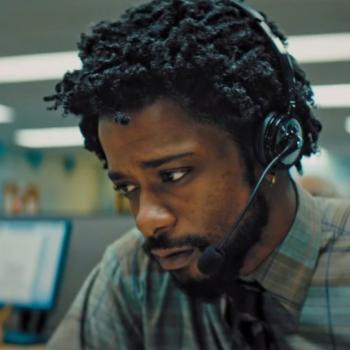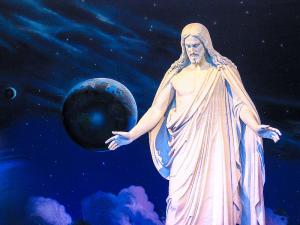The Book of Mormon, the musical comedy co-written by South Park creators Trey Parker and Matt Stone, went into previews on Broadway the week I turned in my dissertation on images of the Latter-day Saints in American culture from 1890 to the present. Sadly, this meant that while I quoted much of Parker and Stone’s work in my dissertation (South Park, Cannibal! The Musical, Orgazmo), I did NOT include a discussion of their Tony-winning musical in my work. Last week, I finally got to see the show, and because I so enjoyed my conversation with Matthew Bowman about Angels in America, I asked him if he’d join me here to help me think through my first encounter with Parker and Stone’s Book of Mormon.
MB: Why Mormons? What is it particularly about Mormonism that makes it an appealing subject for a show like this—as opposed to, say, foreign service officers or the Peace Corps or Mother Teresa?
CHJ: First and foremost, we’re talking about Trey Parker and Matt Stone here. The creators of South Park have long had a fascination with Mormonism that goes at least as far back as their first film, a student project completed at UC-Boulder, Cannibal! The Musical (1993). Mormons also feature prominently in their first feature film, Orgazmo (1997), and several episodes of South Park.
Why not focus on other missionaries or foreign services? If some sort of foreign missionizing is your context, what’s more iconic and more immediately recognizable in American culture than Mormon missionaries? Peace Corps volunteers don’t all have a recognizable style of dress or accessory, but people recognize Mormon missionaries for traveling in pairs, for dressing conservatively (the young men’s “uniform” is especially identifiable), and for wearing those easy-to-spot black name tags.
And as for Mother Teresa… well, I’m not sure even Parker and Stone would take her on as an object of protracted ridicule (she has been featured briefly on South Park in the past). The audience wouldn’t stand for it. Mormons, on the other hand, are totally acceptable to most Americans as the butt of a good joke.
But beyond the Mormons’ status as nationally lampoon-able, I think that Parker and Stone are, like many before them (including Tony Kushner), using Mormons as representatives of a certain kind of self-satisfied, white, middle-class American culture. The show isn’t just a commentary on Mormonism, but rather a critique of contemporary American consumer culture. Much as Aldous Huxley used Mormonism as a means by which to condemn American aesthetics and attitudes in the mid-20th century, Parker and Stone are also using the Mormons to get at larger problems they see in the United States. [1] At least that’s how I read the Salt Lake City backdrops used early in the show, on which the cityscape around the LDS temple fairly bristles with the signs of America’s most famous international exports—fast food chains like McDonald’s and big box stores like Walmart. Or the young missionary’s story of missing his sister’s expected death of cancer because he was standing in line at the Apple store for the new iPhone (“I thought she had time”). Not to mention the missionary chorus’s second act number, “I Am Africa,” in which a bunch of naïve young white men declare themselves one with a romanticized version of that continent in the most politically incorrect terms. (The number reminded me of Hollywood classics like Born Free and the John Wayne vehicle Hatari!, and of course every mid-20th-century issue of National Geographic that lived in my grandparents’ attic.) I think that the Mormons represent for Parker and Stone many of the things that they see wrong in American culture—but also many of the things they think are right with that culture, as well.
MB: Is there anything particularly new or interesting in this depiction of Mormonism? Do you see in it a departure from or confirmation of common themes in Americans’ depiction of Mormonism to date?
CHJ: As I mentioned above, this is not a new approach to depicting Mormons. And really, it’s a standard (albeit often unintentional) way of using representations of minorities in general in the United States. Depictions of ethnic and religious minorities have frequently highlighted issues that the white Protestant cultural majority is anxious about: foreignness, “right” religious belief and practice, changing family dynamics, uncontrolled sexuality. Here, I think Parker and Stone are using the Mormons as a window onto the problems that they see in American culture.
MB: I actually think there is one new thing about this depiction: the Mormons aren’t scary. That’s been a feature of South Park depiction of Mormonism since the beginning, and in a world of Big Love and Jon Krakauer, it’s certainly notable.
CHJ: That’s true, Matt. These Mormons are pretty completely lovable, in spite of the darker implications nibbling around the edges (the domestic abuse and repression of sexual difference discussed in “Turn It Off” come to mind). But it reminds me of something else that’s noteworthy about Parker and Stone’s general approach to the Mormons: they NEVER mention polygamy. In some ways they present a more fair and balanced portrait of the Latter-day Saints than many other American depictions, but then I chalk that up to the fact that they’re both from the intermountain west. Bernard DeVoto, Wallace Stegner, and John Fitzgerald were all unusual in their own day in presenting the Mormons as good folk—and they all grew up in the intermountain west, too.
MB: What particular features of Mormonism did you feel the show emphasizes? What aspects of Mormonism are played up, and what aspects neglected?
CHJ: You can speak to this better than I can, but I found the treatment of Mormon history and theology in the show simplistic at best. While simplicity is a hallmark of musical theater (and much of American popular culture), of course I found that problematic here because, given how little most Americans know about Mormonism, the majority of the people in the audience couldn’t be expected to know what was missing—or even to recognize that there were things missing. (All that said, I have to admit that my favorite number in the show was “Spooky Mormon Hell Dream.” I almost fell out of my seat when, along with Adolf Hitler and Jeffrey Dahmer, two giant cups of coffee showed up to torment the wayward Elder Price.)
I also found the depiction of the missionaries’ attitudes toward the African community and the relationships between the missionaries and the Africans sorely lacking. First and foremost, the idea that the missionaries would show up without even a rudimentary knowledge of the local language is, to me, laughable. The LDS Church is growing rapidly outside of the U.S.—as the oft-quoted statistic goes, there are now more Mormons outside the U.S. than in it—and that could hardly be the case if all Mormon missionaries were as clueless and careless as the group depicted here. Moreover, I get the sense that in reality there is an increasing effort both among Mormon scholars and on the part of the Church to recognize and more deeply engage with the many cultures of its members. These efforts may not be far-reaching enough, but the fact that they’re happening at all indicates a more open and, in many ways, better-informed attitude than Parker and Stone attribute to their missionaries.
MB: I think this is generally right; but, as you repeatedly point out, who goes to a musical expecting nuanced treatments of history and theology? I do think that Parker and Stone made that lack of nuance into a comedic asset, though—placing baldly decontextualized aspects of Mormon theology and life on stage, particularly contrasted with traditional Christian beliefs (as in the song “I Believe”) is generally comedy gold.
CHJ: Too true. (See my comment above about how much I loved “Spooky Mormon Hell Dream,” in spite of all of my scholarly pretensions.) But then, of course, there are shows like Parade (1998), which tackled the trial and lynching of Leo Frank in Atlanta in the 1910s, or Ragtime (1998), which dealt with racism and xenophobia in early-20th-century America, that show that depth isn’t necessarily anathema to the genre. And let’s not forget that Rogers and Hammerstein won a Pulitzer for their treatment of racism in South Pacific (1949).
MB: Some critics have lampooned the show for being basically a minstrel show—both on the part of the Africans and the Mormons. Did you see this? What truth is there in it?
CHJ: Well, of course. The examples I gave above notwithstanding, it’s musical theater. And the creators of South Park. But beyond that, the depiction of the Ugandans is a clear critique of the standard American representations of Africans and other “foreigners.” The show explicitly pokes fun at The Lion King several times, and there’s also an implicit critique of the much-beloved “Small House of Uncle Thomas” number from The King and I.
The depiction of Mormons is rather “minstrelly” in its own way, but as I’ve noted above Mormons are one of the groups that it’s still largely acceptable to inaccurately lampoon in American culture.
MB: To what extent should Mormons recognize themselves in this depiction? Is it at all a constructive critique of Mormonism?
CHJ: As a non-Mormon and a scholar of representations of Mormons rather than Mormons themselves, I’d rather hear what you think about whether or not Mormons should recognize themselves in the show. (Of course, whether they should or not, a number do. There has been a significant positive response to the show among LDS observers.)
The critique that the show delivers, simplistic though it may be, is certainly trying to be constructive. Parker and Stone are demanding that their non-Mormon viewers recognize that, theological differences aside, Mormons are committed to a worldview that demands that they help others in meaningful ways, and that’s to be admired and respected. What I think I found most interesting, though, is that in a Kushner-esque turn that I hadn’t seen discussed in reviews, at show’s end they’re asking their Mormon viewers to embrace the possibilities for change inherent in their own belief in continuing revelation. Like Kushner, they create a contemporary prophet to suit their own needs, and they celebrate the idea of prophecy as one means by which people can adapt to changing and challenging circumstances. Would you agree?
MB: I think you’re exactly right on the last part, and it’s part of what makes Parker and Stone sympathetic to Mormonism generally: Mormons are weird, but they’re weird in a particularly American, self-reinventing sort of way, and their pragmatism may be their most American feature (aside from their niceness). That is, actually, a pretty interesting insight, and one not often picked up on—many observers tend to see Mormonism as monolithic and determinedly conservative.
I actually wonder, though, how many Mormons do have a positive impression of the musical. I think certainly among the internet Mormon intelligentsia the response was reasonably positive, for reasons equally distributed between the desire to embrace something about Mormonism that had a hip pedigree and genuine appreciation for the musical’s insights. Among many non-intelligentsia Mormons, though, there’s still a kneejerk tendency to label non-Church produced depictions of Mormonism as anti-Mormon, and a powerful sensitivity to even the faintest hint of criticism of the Church. I’d be surprised if even a plurality of Mormons has positive impressions of the show.
CHJ: Well, here’s hoping that Patheos readers—Mormon and non-Mormon alike—will let us know what they think.
[1] Tomorrow and Tomorrow and Tomorrow and Other Essays (New York: Harper & Brothers, 1956). A version of this essay appeared in the magazine Encounter (vol. 2 [January 1954]).
* I couldn’t resist adapting one of the show’s song titles—”You and Me (But Mostly Me)“—for the title of this post. I want to thank Matt Bowman not only for his thoughtful questions and comments, but also for his sense of humor.










